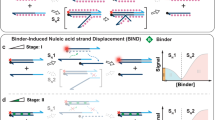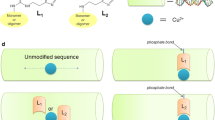Abstract
A long-lived and sequence-specific ligand–DNA complex would make possible the modulation of biological processes for extended periods. For this purpose, we are investigating a polyintercalation approach to DNA recognition in which flexible chains of aromatic units thread back and forth repeatedly through the double helix. Here we describe the DNA-binding behaviour of a threading tetra-intercalator. Specific binding was observed on a relatively long DNA strand that strongly favoured a predicted 14 base-pair sequence. Kinetic studies revealed a multistep association process, with sequence specificity that primarily derives from large differences in dissociation rates. The rate-limiting dissociation rate constant of the tetra-intercalator complex dissociating from its preferred binding site was extremely slow, corresponding to a half-life of 16 days. This is one of the longest non-covalent complex half-lives yet reported and, to the best of our knowledge, the longest for a DNA-binding molecule.
This is a preview of subscription content, access via your institution
Access options
Subscribe to this journal
Receive 12 print issues and online access
$259.00 per year
only $21.58 per issue
Buy this article
- Purchase on Springer Link
- Instant access to full article PDF
Prices may be subject to local taxes which are calculated during checkout




Similar content being viewed by others
References
Dervan, P. B. Design of sequence-specific DNA-binding molecules. Science 232, 464–471 (1986).
Dervan, P. B. Molecular recognition of DNA by small molecules. Bioorg. Med. Chem. 9, 2215–2236 (2001).
Nickols, N. G. & Dervan, P. B. Suppression of androgen receptor-mediated gene expression by a sequence-specific DNA-binding polyamide. Proc. Natl Acad. Sci. USA 104, 10418–10423 (2007).
Muzikar, K. A., Nickols, N. G. & Dervan, P. B. Repression of DNA-binding dependent glucocorticoid receptor-mediated gene expression. Proc. Natl Acad. Sci. USA 106, 16598–16603 (2009).
Fox, K. R. Targeting DNA with triplexes. Curr. Med. Chem. 7, 17–37 (2000).
Arya, D. P. New approaches toward recognition of nucleic acid triple helices. Acc. Chem. Res. 44, 134–146 (2010).
Egholm, M., Buchardt, O., Nielsen, P. E. & Berg, R. H. Peptide nucleic acids (PNA). Oligonucleotide analogues with an achiral peptide backbone. J. Am. Chem. Soc. 114, 1895–1897 (1992).
Janowski, B. A., Hu, J. & Corey, D. R. Silencing gene expression by targeting chromosomal DNA with antigene peptide nucleic acids and duplex RNAs. Nature Protocols 1, 436–443 (2006).
Yen, S. F., Gabbay, E. J. & Wilson, W. D. Interaction of aromatic imides with deoxyribonucleic acid, spectrophotometric and viscometric studies. Biochemistry 21, 2070–2076 (1982).
Tanious, F. A., Yen, S. F. & Wilson, W. D. Kinetic and equilibrium analysis of a threading intercalation mode: DNA sequence and ion effects. Biochemistry 30, 1813–1819 (1991).
Lokey, R. S. et al. A new class of polyintercalating molecules. J. Am. Chem. Soc. 119, 7202–7210 (1997).
Guelev, V. M., Harting, M. T., Lokey, R. S. & Iverson, B. L. Altered sequence specificity identified from a library of DNA-binding small molecules. Chem. Biol. 7, 1–8 (2000).
Guelev, V. et al. Peptide bis-intercalator binds DNA via threading mode with sequence specific contacts in the major groove. Chem. Biol. 8, 415–425 (2001).
Guelev, V., Sorey, S., Hoffman, D. W. & Iverson, B. L. Changing DNA grooves – a 1,4,5,8-naphthalene tetracarboxylic diimide bis-intercalator with the linker (β-Ala)3-Lys in the minor groove. J. Am. Chem. Soc. 124, 2864–2865 (2002).
Lee, J., Guelev, V., Sorey, S., Hoffman, D. W. & Iverson, B. L. NMR structural analysis of a modular threading tetraintercalator bound to DNA. J. Am. Chem. Soc. 126, 14036–14042 (2004).
Chu, Y., Sorey, S., Hoffman, D. W. & Iverson, B. L. Structural characterization of a rigidified threading bisintercalator. J. Am. Chem. Soc. 129, 1304–1311 (2007).
Chu, Y., Hoffman, D. W. & Iverson, B. L. A pseudocatenane structure formed between DNA and a cyclic bisintercalator. J. Am. Chem. Soc. 131, 3499–3508 (2009).
Chaires, J. B., Dattagupta, N. & Crothers, D. M. Kinetics of the daunomycin–DNA interaction. Biochemistry 24, 260–267 (1985).
Wilson, W. D. et al. DNA sequence dependent binding modes of 4′,6-diamidino-2-phenylindole (DAPI). Biochemistry 29, 8452–8461 (1990).
Tanious, F. A., Veal, J. M., Buczak, H., Ratmeyer, L. S. & Wilson, W. D. DAPI (4′,6-diamidino-2-phenylindole) binds differently to DNA and RNA: minor-groove binding at AT sites and intercalation at AU sites. Biochemistry 31, 3103–3112 (1992).
Wilson, W. D., Krishnamoorthy, C. R., Wang, Y. H. & Smith, J. C. Mechanism of intercalation: ion effects on the equilibrium and kinetic constants for the interaction of propidium and ethidium with DNA. Biopolymers 24, 1941–1961 (1985).
Westerlund, F., Wilhelmsson, L. M., Nordén, B. & Lincoln, P. Monitoring the DNA binding kinetics of a binuclear ruthenium complex by energy transfer: evidence for slow shuffling. J. Phys. Chem. B 109, 21140–21144 (2005).
Westerlund, F., Nordell, P., Nordén, B. & Lincoln, P. Kinetic characterization of an extremely slow DNA binding equilibrium. J. Phys. Chem. B 111, 9132–9137 (2007).
Leng, F., Priebe, W. & Chaires, J. B. Ultratight DNA binding of a new bisintercalating anthracycline antibiotic. Biochemistry 37, 1743–1753 (1998).
Hampshire, A. J., Rusling, D. A., Broughton-Head, V. J. & Fox, K. R. Footprinting: a method for determining sequence selectivity, affinity and kinetics of DNA-binding ligands. Methods 42, 128–140 (2007).
Müller, W. & Crothers, D. M. Studies of the binding of actinomycin and related compounds to DNA. J. Mol. Biol. 35, 251–290 (1968).
Westerlund, F., Wilhelmsson, L. M., Nordén, B. & Lincoln, P. Micelle-sequestered dissociation of cationic DNA-intercalated drugs: unexpected surfactant-induced rate enhancement. J. Am. Chem. Soc. 125, 3773–3779 (2003).
Anslyn, E. V. & Dougherty, D. A. Modern Physical Organic Chemistry (University Science Books, 2006).
Johnson, K. A., Simpson, Z. B. & Blom, T. Global Kinetic Explorer: a new computer program for dynamic simulation and fitting of kinetic data. Anal. Biochem. 387, 20–29 (2009).
Bevilacqua, P. C., Kierzek, R., Johnson, K. A. & Turner, D. H. Dynamics of ribozyme binding of substrate revealed by fluorescence-detected stopped-flow methods. Science 258, 1355–1358 (1992).
Rao, J., Lahiri, J., Isaacs, L., Weis, R. M. & Whitesides, G. M. A trivalent system from vancomycin-D-Ala-D-Ala with higher affinity than avidin–biotin. Science 280, 708–711 (1998).
Boder, E. T., Midelfort, K. S. & Wittrup, K. D. Directed evolution of antibody fragments with monovalent femtomolar antigen-binding affinity. Proc. Natl Acad. Sci. USA 97, 10701–10705 (2000).
Graff, C. P., Chester, K., Begent, R. & Wittrup, K. D. Directed evolution of an anti-carcinoembryonic antigen scFv with a 4-day monovalent dissociation half-time at 37 °C. Protein Eng. Des. Sel. 17, 293–304 (2004).
Rajpal, A. et al. A general method for greatly improving the affinity of antibodies by using combinatorial libraries. Proc. Natl Acad. Sci. USA 102, 8466–8471 (2005).
Green, N. M. Avidin: 1-The use of [14C]biotin for kinetic studies and for assay. Biochem. J. 89, 585–591 (1963).
Piran, U. & Riordan, W. J. Dissociation rate constant of the biotin–streptavidin complex. J. Immunol. Meth. 133, 141–143 (1990).
Guelev, V. M., Cubberley, M. S., Murr, M. M., Lokey, R. S. & Iverson, B. L. Design, synthesis, and characterization of polyintercalating ligands. Methods Enzymol. 340, 556–570 (2001).
Hayhurst, A. et al. Isolation and expression of recombinant antibody fragments to the biological warfare pathogen Brucella melitensis. J. Immunol. Methods 276, 185–196 (2003).
Trauger, J. W. & Dervan, P. B. Footprinting methods for analysis of pyrrole–imidazole polyamide/DNA complexes. Methods Enzymol. 340, 450–466 (2001).
Iverson, B. L. & Dervan, P. B. Adenine specific DNA chemical sequencing reaction. Nucleic Acids Res. 15, 7823–7830 (1987).
Acknowledgements
This work was supported by the Robert A. Welch Foundation (grant F1188 to B.L.I., F1604 to K.A.J. and departmental grant AF-0005 to M.Z.F.) and the National Institutes of Health (grant GM-069647 to B.L.I.). Acknowledgement is made to the Donors of the American Chemical Society Petroleum Research Fund for partial support of this research (M.Z.F.). M.Z.F. was also supported by the Southwestern University faculty sabbatical program. We thank Steven Sorey for his help with the 1H NMR spectra.
Author information
Authors and Affiliations
Contributions
G.G.H., M.Z.F. and A.R.S. performed the experiments. G.G.H., M.Z.F., A.R.S., K.A.J. and B.L.I. designed the experiments and analysed the data. G.G.H., M.Z.F. and B.L.I. co-wrote the paper.
Corresponding author
Ethics declarations
Competing interests
The authors declare no competing financial interests.
Supplementary information
Supplementary information
Supplementary information (PDF 552 kb)
Rights and permissions
About this article
Cite this article
Holman, G., Zewail-Foote, M., Smith, A. et al. A sequence-specific threading tetra-intercalator with an extremely slow dissociation rate constant. Nature Chem 3, 875–881 (2011). https://doi.org/10.1038/nchem.1151
Received:
Accepted:
Published:
Issue Date:
DOI: https://doi.org/10.1038/nchem.1151
This article is cited by
-
Heat-shrinking DNA nanoparticles for in vivo gene delivery
Gene Therapy (2020)
-
Diazapyrenes: interaction with nucleic acids and biological activity
Chemistry of Heterocyclic Compounds (2020)
-
Ethyl-substitutive Thioflavin T as a highly-specific fluorescence probe for detecting G-quadruplex structure
Scientific Reports (2018)
-
Single molecule high-throughput footprinting of small and large DNA ligands
Nature Communications (2017)
-
Bioinspired Nanoarchitectonics of Naphthalene Diimide to Access 2D Sheets of Tunable Size, Shape, and Optoelectronic Properties
Journal of Inorganic and Organometallic Polymers and Materials (2015)




